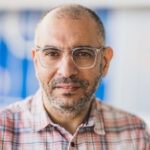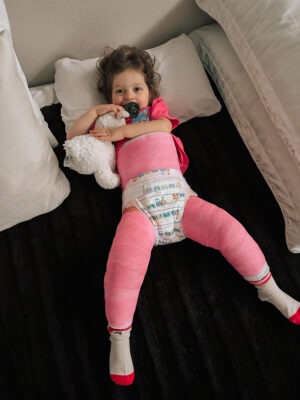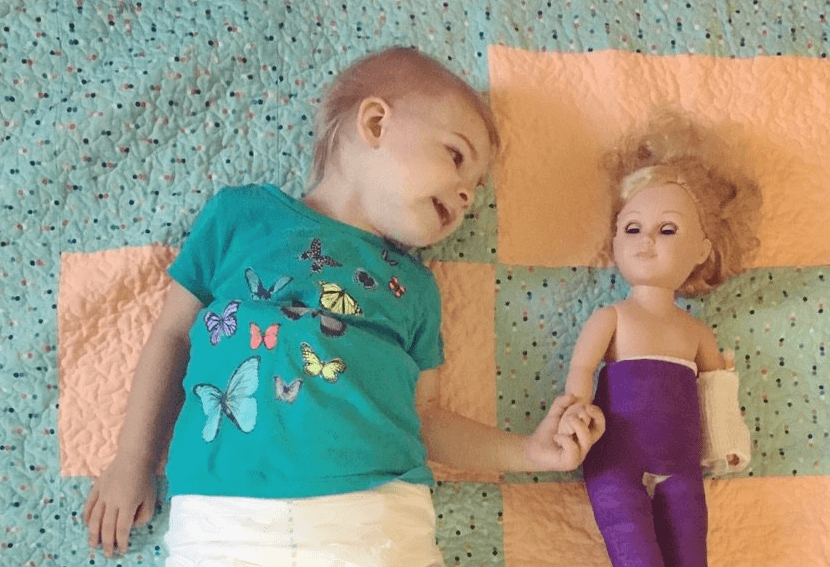
A blood transfusion alternative for hip dysplasia surgery at MCH
When Bella was 18 months old, her parents began to worry because they noticed she wasn’t starting to walk. After voicing their concerns to their family doctor and visiting a pediatrician, x-rays showed one of Bella’s legs was shorter than the other. She was diagnosed with developmental dysplasia of the hip (DDH) which is when the ball-and-socket joint of the hip doesn’t properly develop and form in young children. The only way to correct this is with surgery.
As Bella’s road to surgery began, her pediatric orthopedic surgeon and team at McMaster Children’s Hospital (MCH) worked very closely with the family to develop a plan, while also respecting their religious-based request to not use blood transfusions. In standard practice, blood transfusions take place if too much blood is lost during a surgical procedure.
Swapping blood transfusions for blood salvaging

Dr. Waleed Kishta is a pediatric orthopedic surgeon and head of orthopedic surgery at MCH.
Last August, Dr. Waleed Kishta, pediatric orthopedic surgeon and head of orthopedic surgery at MCH, was introduced to Bella’s case and worked with her parents to find other ways of performing surgery without blood transfusions.
“We explained to Dr. Kishta that we don’t accept blood transfusions for religious reasons,” says Tanya Moraitis, Bella’s mother. “While we don’t accept transfusions, whole blood or its four major components, we can accept alternatives such as minor blood fractions and cell salvage, amongst other things.”
As this was a first for Kishta, he started looking into other alternatives. After a few months of conducting research and meeting with church representatives connected with the family, the option of blood salvaging came forward. Blood salvaging uses a cell saver device and the process involves collecting the blood lost during surgery, cleaning it, and returning it back to the patient. Bella’s parents were comfortable with this option and proceeded with the surgery.
Surgery for Bella’s “owie”

Despite this little one’s journey, she’s as happy as can be.
In February, Bella, then 28 months old, underwent her surgery. The surgery consisted of cutting the femur bone and reshaping it to fit into the hip socket.
“We tried our best to explain to Bella a couple of weeks before that she was going into the hospital to fix an ‘owie’ that she had on her left leg,” says Moraitis. DDH correctional surgery can take up to five hours in the operating room.
“Leaving her there and walking away was gut-wrenching, but I knew she was in good hands as I took a last glance at Dr. Kishta and waved goodbye to him,” says Moraitis. “As parents, we felt anxious and nervous. You just want the best for your child and want to take away any pain they have. We knew this surgery had to be done and were confident in Dr. Kishta.”
Bella’s four-hour surgery was successful, and blood salvaging wasn’t needed.
Working together for a successful outcome

Bella showing off her pink spica cast post-surgery that she wore for seven weeks.
Post-surgical care for Bella included having to wear a spica cast for seven weeks. This type of cast is used to treat hip conditions in an effort to keep the child’s hips and both legs (in Bella’s case) in the right position to heal. The child isn’t able to move or bend at the hips while wearing the cast.
At Bella’s two-week follow-up appointment with Kishta, x-rays showed her healing process was going incredibly well. On March 3, Bella’s spica cast was removed. She has to wear a brace at night for the next six months to ensure everything is healing properly.
Nurse practitioner in orthopedic surgery, Kristine Tomczyk, worked alongside Bella’s health-care team and her family. “Bella’s successes are not the result of a single person caring for Bella, but of a multitude of dedicated people skilled in their respective crafts that worked in collaboration with her wonderful parents,” says Tomczyk. “Her parents were cooperative, patient, and eager to learn. They were lovely to work with.”
Bella is now encouraged to start slowly walking and getting back to her normal everyday activities. Kishta and the team continue to monitor Bella’s development in upcoming appointments.
A team going above and beyond
“We look after a large number of patients with hip dysplasia at our hospital,” says Kishta. “These are very crucial cases that need to be diagnosed on a timely basis.”

Bella is encouraged to walk and get back to her regular activities during her recovery.
The Moraitis family extends their gratitude to the team and is extremely happy with the progress little Bella has made along her journey. “The nurses, residents, doctors, and everyone in between were phenomenal, pre and post-surgery,” says Moraitis. “Everyone was willing to answer any questions we had, and were very patient and kind.”
Moraitis adds, “Dr. Kishta is an amazing surgeon who is both kind and humble. He truly did not rush us and was beyond patient. The hospital gave us all of the support that we needed to go into surgery day with a positive frame of mind. Everyone truly went above and beyond.”

